Financial Accounting and Reporting: Depreciation, Impairment and Revaluation
VerifiedAdded on 2023/06/07
|7
|2146
|395
AI Summary
This article explains the difference between depreciation, impairment and revaluation losses, their impact on profitability, why changes are required for depreciation, impairment and revaluation, necessary disclosures and how to report on performance without upsetting managers.
Contribute Materials
Your contribution can guide someone’s learning journey. Share your
documents today.
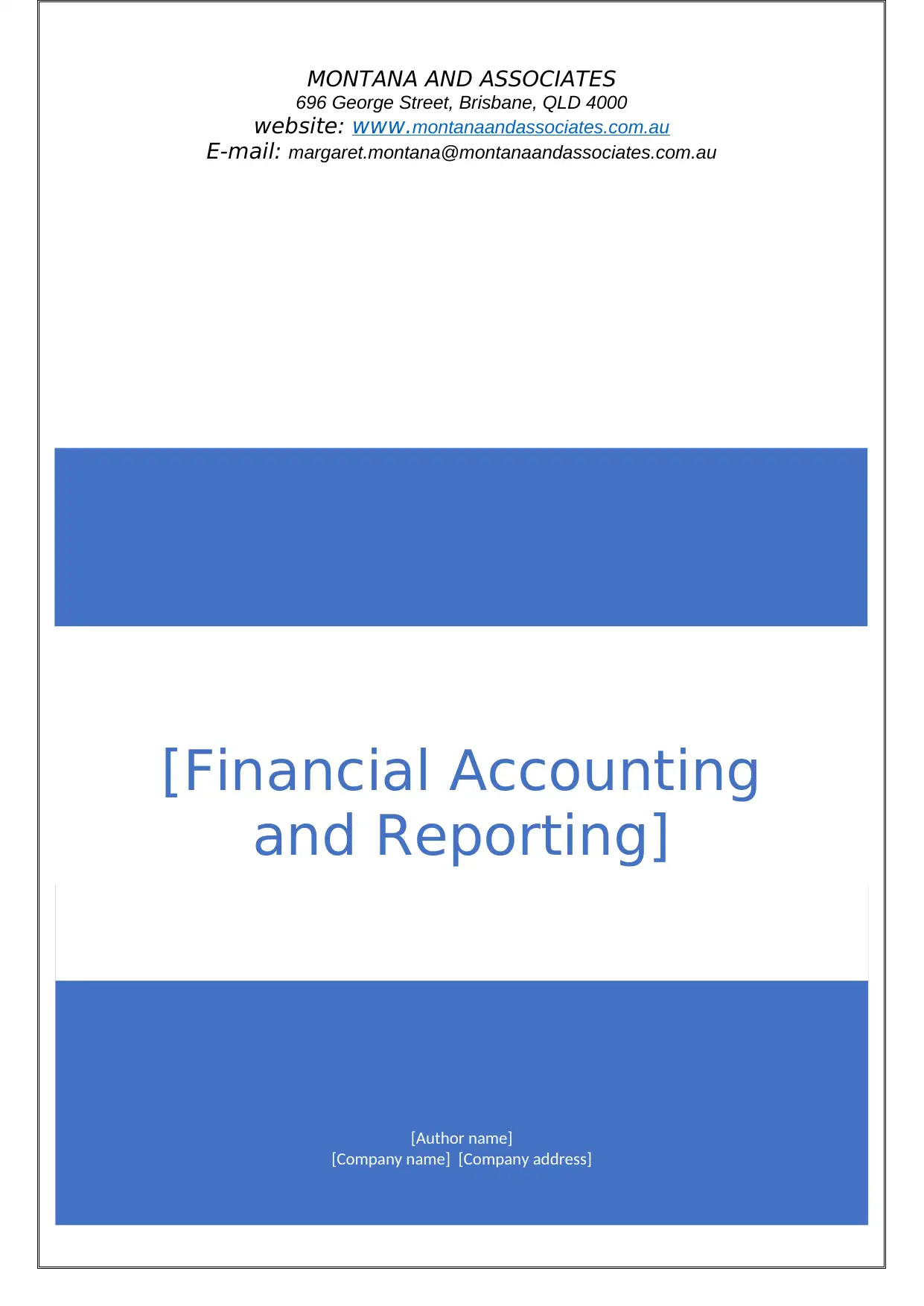
[Author name]
[Company name] [Company address]
[Financial Accounting
and Reporting]
MONTANA AND ASSOCIATES
696 George Street, Brisbane, QLD 4000
website: www.montanaandassociates.com.au
E-mail: margaret.montana@montanaandassociates.com.au
[Company name] [Company address]
[Financial Accounting
and Reporting]
MONTANA AND ASSOCIATES
696 George Street, Brisbane, QLD 4000
website: www.montanaandassociates.com.au
E-mail: margaret.montana@montanaandassociates.com.au
Secure Best Marks with AI Grader
Need help grading? Try our AI Grader for instant feedback on your assignments.
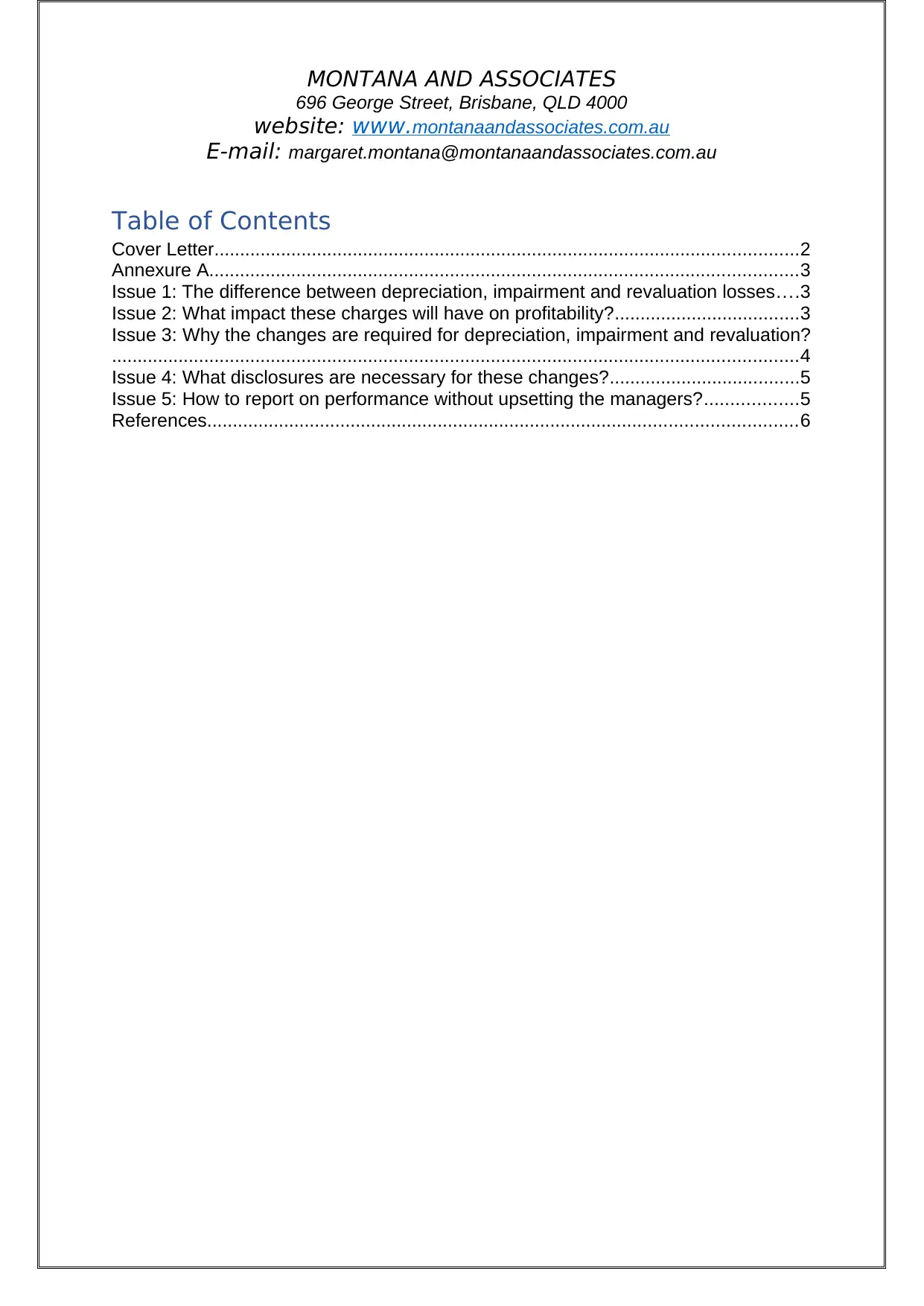
MONTANA AND ASSOCIATES
696 George Street, Brisbane, QLD 4000
website: www.montanaandassociates.com.au
E-mail: margaret.montana@montanaandassociates.com.au
Table of Contents
Cover Letter..................................................................................................................2
Annexure A...................................................................................................................3
Issue 1: The difference between depreciation, impairment and revaluation losses....3
Issue 2: What impact these charges will have on profitability?....................................3
Issue 3: Why the changes are required for depreciation, impairment and revaluation?
......................................................................................................................................4
Issue 4: What disclosures are necessary for these changes?.....................................5
Issue 5: How to report on performance without upsetting the managers?..................5
References...................................................................................................................6
696 George Street, Brisbane, QLD 4000
website: www.montanaandassociates.com.au
E-mail: margaret.montana@montanaandassociates.com.au
Table of Contents
Cover Letter..................................................................................................................2
Annexure A...................................................................................................................3
Issue 1: The difference between depreciation, impairment and revaluation losses....3
Issue 2: What impact these charges will have on profitability?....................................3
Issue 3: Why the changes are required for depreciation, impairment and revaluation?
......................................................................................................................................4
Issue 4: What disclosures are necessary for these changes?.....................................5
Issue 5: How to report on performance without upsetting the managers?..................5
References...................................................................................................................6
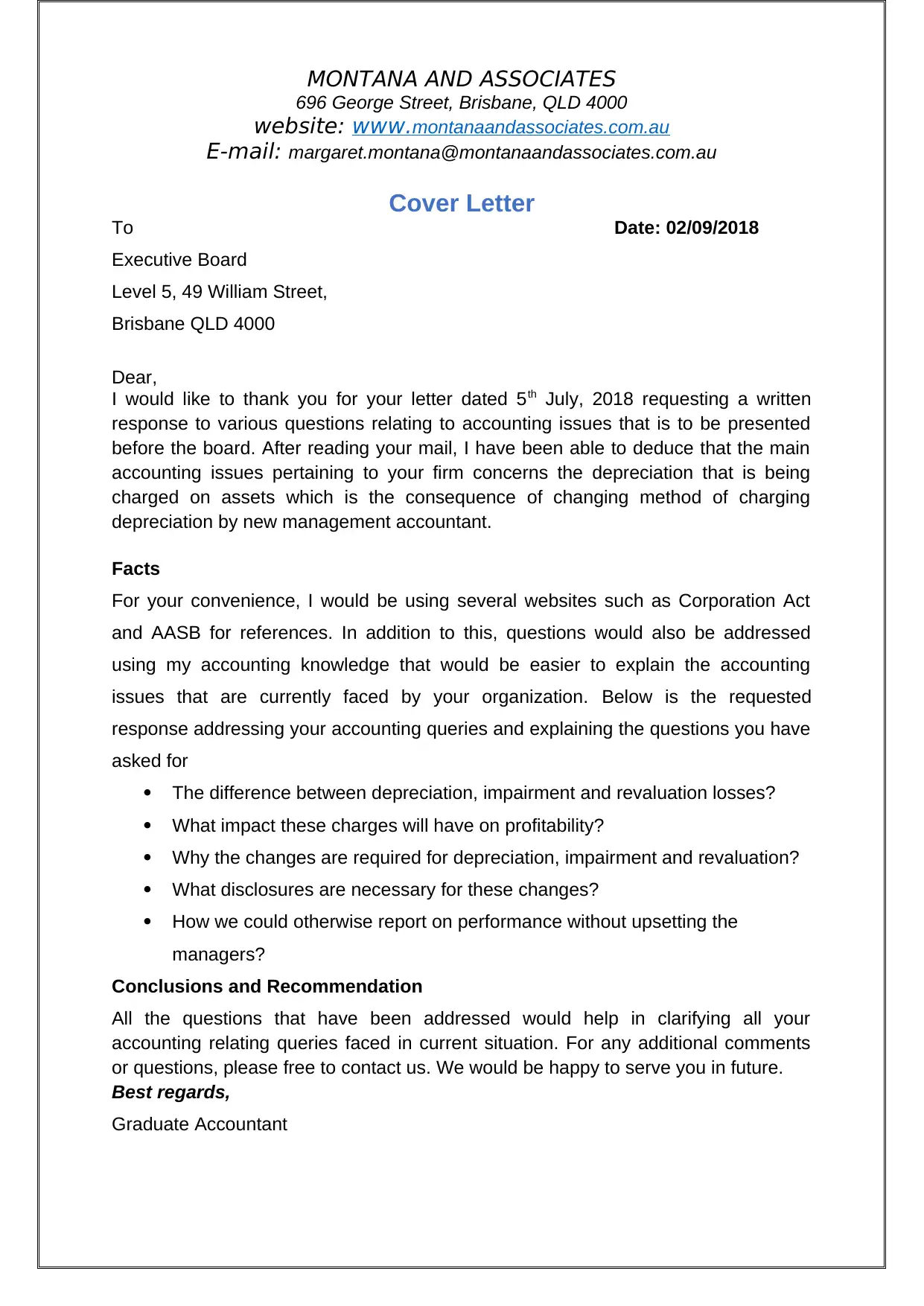
MONTANA AND ASSOCIATES
696 George Street, Brisbane, QLD 4000
website: www.montanaandassociates.com.au
E-mail: margaret.montana@montanaandassociates.com.au
Cover Letter
To Date: 02/09/2018
Executive Board
Level 5, 49 William Street,
Brisbane QLD 4000
Dear,
I would like to thank you for your letter dated 5th July, 2018 requesting a written
response to various questions relating to accounting issues that is to be presented
before the board. After reading your mail, I have been able to deduce that the main
accounting issues pertaining to your firm concerns the depreciation that is being
charged on assets which is the consequence of changing method of charging
depreciation by new management accountant.
Facts
For your convenience, I would be using several websites such as Corporation Act
and AASB for references. In addition to this, questions would also be addressed
using my accounting knowledge that would be easier to explain the accounting
issues that are currently faced by your organization. Below is the requested
response addressing your accounting queries and explaining the questions you have
asked for
The difference between depreciation, impairment and revaluation losses?
What impact these charges will have on profitability?
Why the changes are required for depreciation, impairment and revaluation?
What disclosures are necessary for these changes?
How we could otherwise report on performance without upsetting the
managers?
Conclusions and Recommendation
All the questions that have been addressed would help in clarifying all your
accounting relating queries faced in current situation. For any additional comments
or questions, please free to contact us. We would be happy to serve you in future.
Best regards,
Graduate Accountant
696 George Street, Brisbane, QLD 4000
website: www.montanaandassociates.com.au
E-mail: margaret.montana@montanaandassociates.com.au
Cover Letter
To Date: 02/09/2018
Executive Board
Level 5, 49 William Street,
Brisbane QLD 4000
Dear,
I would like to thank you for your letter dated 5th July, 2018 requesting a written
response to various questions relating to accounting issues that is to be presented
before the board. After reading your mail, I have been able to deduce that the main
accounting issues pertaining to your firm concerns the depreciation that is being
charged on assets which is the consequence of changing method of charging
depreciation by new management accountant.
Facts
For your convenience, I would be using several websites such as Corporation Act
and AASB for references. In addition to this, questions would also be addressed
using my accounting knowledge that would be easier to explain the accounting
issues that are currently faced by your organization. Below is the requested
response addressing your accounting queries and explaining the questions you have
asked for
The difference between depreciation, impairment and revaluation losses?
What impact these charges will have on profitability?
Why the changes are required for depreciation, impairment and revaluation?
What disclosures are necessary for these changes?
How we could otherwise report on performance without upsetting the
managers?
Conclusions and Recommendation
All the questions that have been addressed would help in clarifying all your
accounting relating queries faced in current situation. For any additional comments
or questions, please free to contact us. We would be happy to serve you in future.
Best regards,
Graduate Accountant

MONTANA AND ASSOCIATES
696 George Street, Brisbane, QLD 4000
website: www.montanaandassociates.com.au
E-mail: margaret.montana@montanaandassociates.com.au
Annexure
A
Issue 1: The difference between depreciation, impairment and revaluation losses?
Depreciation: Depreciation is the allocation of depreciable amount of particular
assets over their useful life in a systematic manner (Klychova et al. 2015). There are
varieties of depreciation methods that can be used by organization depending upon
their suitability. It is bring to your knowledge that the noncurrent assets regarding
depreciation as per the International accounting standard. It is required by entity to
make disclosure of the specific information relating to the depreciable assets and
their amount.
Impairment: Your concern about impairment of assets requires me to give the
explanation of the same. Impairment of assets is done when there is fall in assets
fair value below the cost that is recorded. Hence, there arises the need to compute
the difference between recorded cost and fair value. At the end of reporting period, it
is required by your organization to make the assessment of any impairment
indication (Gaynor et al. 2016). In addition to this, it is also required to conduct the
impairment test for intangible assets and those acquired in business combination.
Revaluation Loss: Revaluation of assets is another important concept seeking
explanation that concentrates on revaluation model. Such model provides entity with
the option of carrying the assets at revalued amount. I would like to acquaint that
there should be continuous revaluation of fixed assets for ensuring that there do not
exist any material difference between carrying value and fair value of assets. Surplus
or loss resulting from revaluation has different accounting treatment. If value of
assets decrease after revaluation, then such reduced value is treated in the profit
and loss statement (Camilleri and Camilleri 2017). On other hand, an increase in
value is treated as surplus.
Issue 2: What impact these charges will have on profitability?
Depreciation: Secondly, I would like to give an explanation about the impact of
deprecation charge on business profitability. Change in accounting estimate results
from any alteration in depreciation method. Impact of depreciation charge is required
to be recognized in that particular period if the effect of such change is in the same
period. However, any operating segments adjustments by way of retained profits and
accumulated loss should not make any alteration in depreciation charge of the prior
696 George Street, Brisbane, QLD 4000
website: www.montanaandassociates.com.au
E-mail: margaret.montana@montanaandassociates.com.au
Annexure
A
Issue 1: The difference between depreciation, impairment and revaluation losses?
Depreciation: Depreciation is the allocation of depreciable amount of particular
assets over their useful life in a systematic manner (Klychova et al. 2015). There are
varieties of depreciation methods that can be used by organization depending upon
their suitability. It is bring to your knowledge that the noncurrent assets regarding
depreciation as per the International accounting standard. It is required by entity to
make disclosure of the specific information relating to the depreciable assets and
their amount.
Impairment: Your concern about impairment of assets requires me to give the
explanation of the same. Impairment of assets is done when there is fall in assets
fair value below the cost that is recorded. Hence, there arises the need to compute
the difference between recorded cost and fair value. At the end of reporting period, it
is required by your organization to make the assessment of any impairment
indication (Gaynor et al. 2016). In addition to this, it is also required to conduct the
impairment test for intangible assets and those acquired in business combination.
Revaluation Loss: Revaluation of assets is another important concept seeking
explanation that concentrates on revaluation model. Such model provides entity with
the option of carrying the assets at revalued amount. I would like to acquaint that
there should be continuous revaluation of fixed assets for ensuring that there do not
exist any material difference between carrying value and fair value of assets. Surplus
or loss resulting from revaluation has different accounting treatment. If value of
assets decrease after revaluation, then such reduced value is treated in the profit
and loss statement (Camilleri and Camilleri 2017). On other hand, an increase in
value is treated as surplus.
Issue 2: What impact these charges will have on profitability?
Depreciation: Secondly, I would like to give an explanation about the impact of
deprecation charge on business profitability. Change in accounting estimate results
from any alteration in depreciation method. Impact of depreciation charge is required
to be recognized in that particular period if the effect of such change is in the same
period. However, any operating segments adjustments by way of retained profits and
accumulated loss should not make any alteration in depreciation charge of the prior
Secure Best Marks with AI Grader
Need help grading? Try our AI Grader for instant feedback on your assignments.
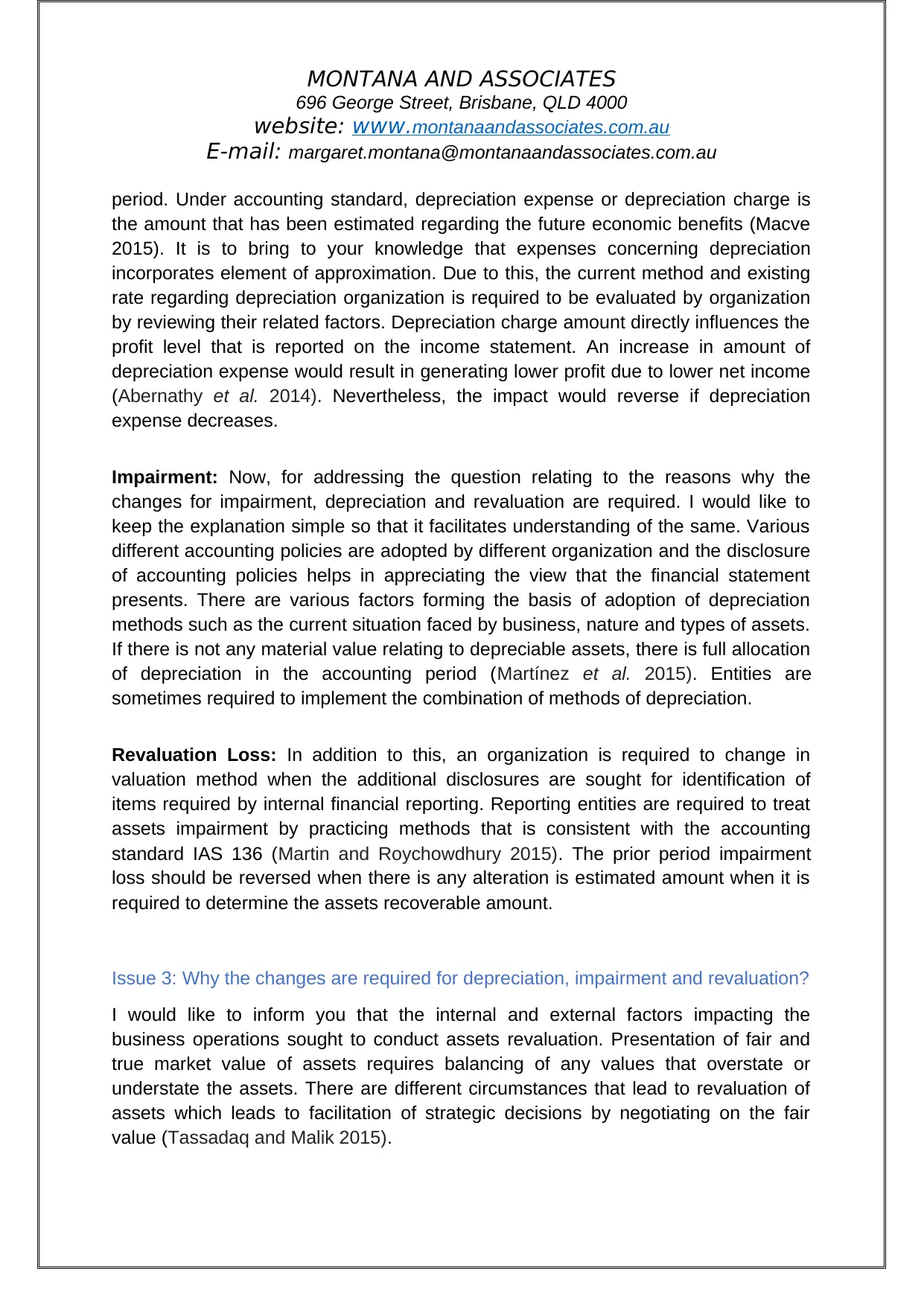
MONTANA AND ASSOCIATES
696 George Street, Brisbane, QLD 4000
website: www.montanaandassociates.com.au
E-mail: margaret.montana@montanaandassociates.com.au
period. Under accounting standard, depreciation expense or depreciation charge is
the amount that has been estimated regarding the future economic benefits (Macve
2015). It is to bring to your knowledge that expenses concerning depreciation
incorporates element of approximation. Due to this, the current method and existing
rate regarding depreciation organization is required to be evaluated by organization
by reviewing their related factors. Depreciation charge amount directly influences the
profit level that is reported on the income statement. An increase in amount of
depreciation expense would result in generating lower profit due to lower net income
(Abernathy et al. 2014). Nevertheless, the impact would reverse if depreciation
expense decreases.
Impairment: Now, for addressing the question relating to the reasons why the
changes for impairment, depreciation and revaluation are required. I would like to
keep the explanation simple so that it facilitates understanding of the same. Various
different accounting policies are adopted by different organization and the disclosure
of accounting policies helps in appreciating the view that the financial statement
presents. There are various factors forming the basis of adoption of depreciation
methods such as the current situation faced by business, nature and types of assets.
If there is not any material value relating to depreciable assets, there is full allocation
of depreciation in the accounting period (Martínez et al. 2015). Entities are
sometimes required to implement the combination of methods of depreciation.
Revaluation Loss: In addition to this, an organization is required to change in
valuation method when the additional disclosures are sought for identification of
items required by internal financial reporting. Reporting entities are required to treat
assets impairment by practicing methods that is consistent with the accounting
standard IAS 136 (Martin and Roychowdhury 2015). The prior period impairment
loss should be reversed when there is any alteration is estimated amount when it is
required to determine the assets recoverable amount.
Issue 3: Why the changes are required for depreciation, impairment and revaluation?
I would like to inform you that the internal and external factors impacting the
business operations sought to conduct assets revaluation. Presentation of fair and
true market value of assets requires balancing of any values that overstate or
understate the assets. There are different circumstances that lead to revaluation of
assets which leads to facilitation of strategic decisions by negotiating on the fair
value (Tassadaq and Malik 2015).
696 George Street, Brisbane, QLD 4000
website: www.montanaandassociates.com.au
E-mail: margaret.montana@montanaandassociates.com.au
period. Under accounting standard, depreciation expense or depreciation charge is
the amount that has been estimated regarding the future economic benefits (Macve
2015). It is to bring to your knowledge that expenses concerning depreciation
incorporates element of approximation. Due to this, the current method and existing
rate regarding depreciation organization is required to be evaluated by organization
by reviewing their related factors. Depreciation charge amount directly influences the
profit level that is reported on the income statement. An increase in amount of
depreciation expense would result in generating lower profit due to lower net income
(Abernathy et al. 2014). Nevertheless, the impact would reverse if depreciation
expense decreases.
Impairment: Now, for addressing the question relating to the reasons why the
changes for impairment, depreciation and revaluation are required. I would like to
keep the explanation simple so that it facilitates understanding of the same. Various
different accounting policies are adopted by different organization and the disclosure
of accounting policies helps in appreciating the view that the financial statement
presents. There are various factors forming the basis of adoption of depreciation
methods such as the current situation faced by business, nature and types of assets.
If there is not any material value relating to depreciable assets, there is full allocation
of depreciation in the accounting period (Martínez et al. 2015). Entities are
sometimes required to implement the combination of methods of depreciation.
Revaluation Loss: In addition to this, an organization is required to change in
valuation method when the additional disclosures are sought for identification of
items required by internal financial reporting. Reporting entities are required to treat
assets impairment by practicing methods that is consistent with the accounting
standard IAS 136 (Martin and Roychowdhury 2015). The prior period impairment
loss should be reversed when there is any alteration is estimated amount when it is
required to determine the assets recoverable amount.
Issue 3: Why the changes are required for depreciation, impairment and revaluation?
I would like to inform you that the internal and external factors impacting the
business operations sought to conduct assets revaluation. Presentation of fair and
true market value of assets requires balancing of any values that overstate or
understate the assets. There are different circumstances that lead to revaluation of
assets which leads to facilitation of strategic decisions by negotiating on the fair
value (Tassadaq and Malik 2015).
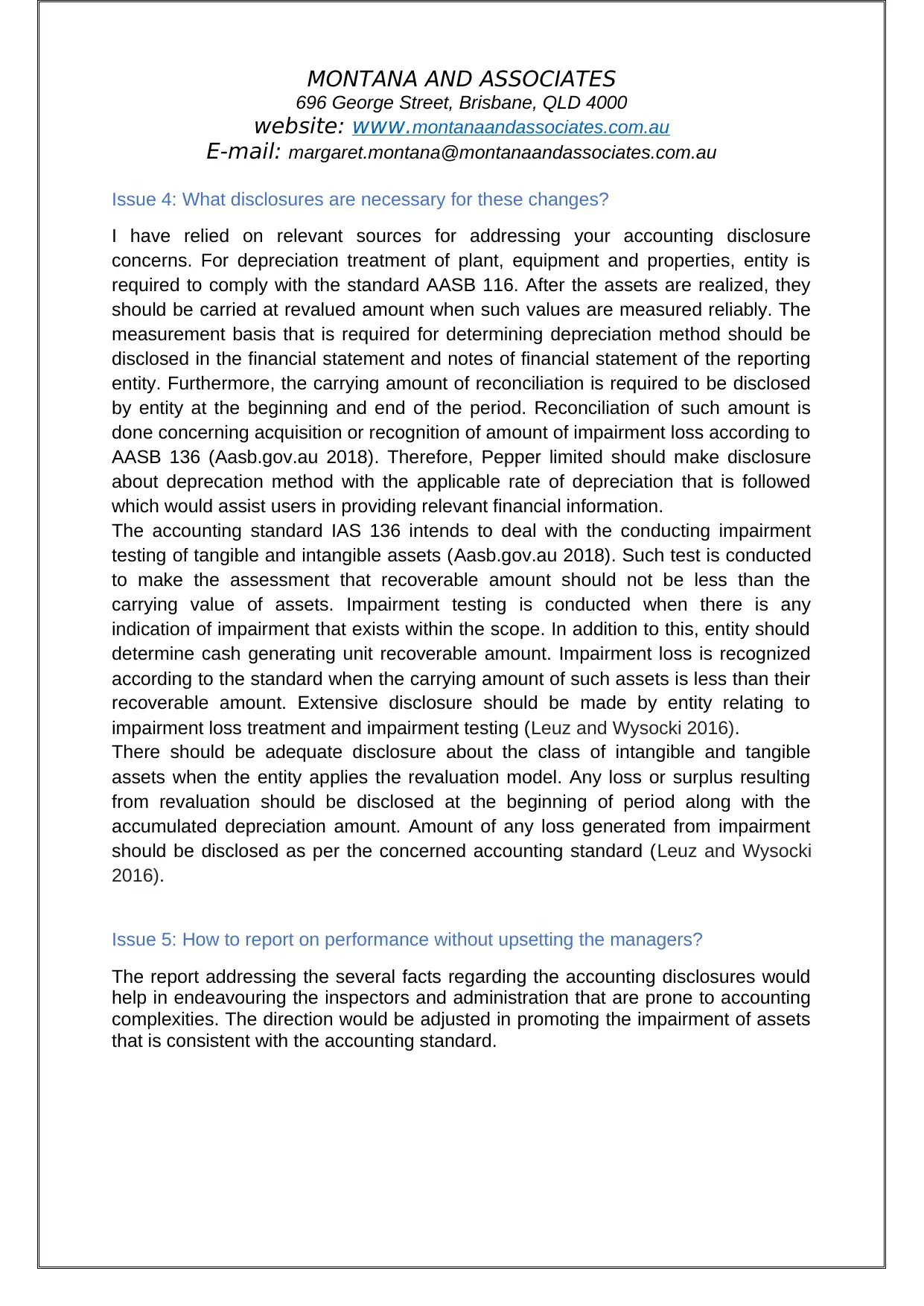
MONTANA AND ASSOCIATES
696 George Street, Brisbane, QLD 4000
website: www.montanaandassociates.com.au
E-mail: margaret.montana@montanaandassociates.com.au
Issue 4: What disclosures are necessary for these changes?
I have relied on relevant sources for addressing your accounting disclosure
concerns. For depreciation treatment of plant, equipment and properties, entity is
required to comply with the standard AASB 116. After the assets are realized, they
should be carried at revalued amount when such values are measured reliably. The
measurement basis that is required for determining depreciation method should be
disclosed in the financial statement and notes of financial statement of the reporting
entity. Furthermore, the carrying amount of reconciliation is required to be disclosed
by entity at the beginning and end of the period. Reconciliation of such amount is
done concerning acquisition or recognition of amount of impairment loss according to
AASB 136 (Aasb.gov.au 2018). Therefore, Pepper limited should make disclosure
about deprecation method with the applicable rate of depreciation that is followed
which would assist users in providing relevant financial information.
The accounting standard IAS 136 intends to deal with the conducting impairment
testing of tangible and intangible assets (Aasb.gov.au 2018). Such test is conducted
to make the assessment that recoverable amount should not be less than the
carrying value of assets. Impairment testing is conducted when there is any
indication of impairment that exists within the scope. In addition to this, entity should
determine cash generating unit recoverable amount. Impairment loss is recognized
according to the standard when the carrying amount of such assets is less than their
recoverable amount. Extensive disclosure should be made by entity relating to
impairment loss treatment and impairment testing (Leuz and Wysocki 2016).
There should be adequate disclosure about the class of intangible and tangible
assets when the entity applies the revaluation model. Any loss or surplus resulting
from revaluation should be disclosed at the beginning of period along with the
accumulated depreciation amount. Amount of any loss generated from impairment
should be disclosed as per the concerned accounting standard (Leuz and Wysocki
2016).
Issue 5: How to report on performance without upsetting the managers?
The report addressing the several facts regarding the accounting disclosures would
help in endeavouring the inspectors and administration that are prone to accounting
complexities. The direction would be adjusted in promoting the impairment of assets
that is consistent with the accounting standard.
696 George Street, Brisbane, QLD 4000
website: www.montanaandassociates.com.au
E-mail: margaret.montana@montanaandassociates.com.au
Issue 4: What disclosures are necessary for these changes?
I have relied on relevant sources for addressing your accounting disclosure
concerns. For depreciation treatment of plant, equipment and properties, entity is
required to comply with the standard AASB 116. After the assets are realized, they
should be carried at revalued amount when such values are measured reliably. The
measurement basis that is required for determining depreciation method should be
disclosed in the financial statement and notes of financial statement of the reporting
entity. Furthermore, the carrying amount of reconciliation is required to be disclosed
by entity at the beginning and end of the period. Reconciliation of such amount is
done concerning acquisition or recognition of amount of impairment loss according to
AASB 136 (Aasb.gov.au 2018). Therefore, Pepper limited should make disclosure
about deprecation method with the applicable rate of depreciation that is followed
which would assist users in providing relevant financial information.
The accounting standard IAS 136 intends to deal with the conducting impairment
testing of tangible and intangible assets (Aasb.gov.au 2018). Such test is conducted
to make the assessment that recoverable amount should not be less than the
carrying value of assets. Impairment testing is conducted when there is any
indication of impairment that exists within the scope. In addition to this, entity should
determine cash generating unit recoverable amount. Impairment loss is recognized
according to the standard when the carrying amount of such assets is less than their
recoverable amount. Extensive disclosure should be made by entity relating to
impairment loss treatment and impairment testing (Leuz and Wysocki 2016).
There should be adequate disclosure about the class of intangible and tangible
assets when the entity applies the revaluation model. Any loss or surplus resulting
from revaluation should be disclosed at the beginning of period along with the
accumulated depreciation amount. Amount of any loss generated from impairment
should be disclosed as per the concerned accounting standard (Leuz and Wysocki
2016).
Issue 5: How to report on performance without upsetting the managers?
The report addressing the several facts regarding the accounting disclosures would
help in endeavouring the inspectors and administration that are prone to accounting
complexities. The direction would be adjusted in promoting the impairment of assets
that is consistent with the accounting standard.
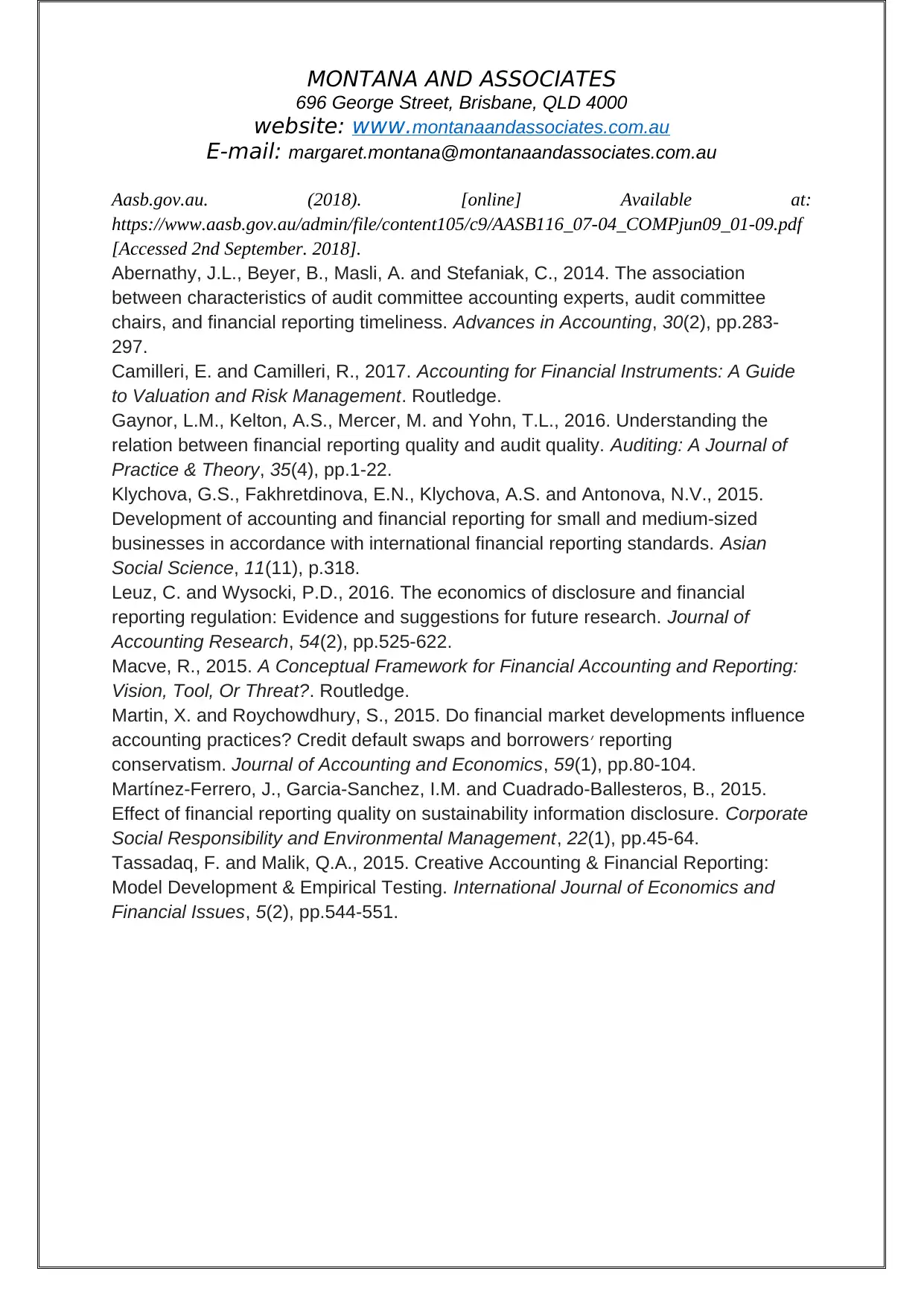
MONTANA AND ASSOCIATES
696 George Street, Brisbane, QLD 4000
website: www.montanaandassociates.com.au
E-mail: margaret.montana@montanaandassociates.com.au
Aasb.gov.au. (2018). [online] Available at:
https://www.aasb.gov.au/admin/file/content105/c9/AASB116_07-04_COMPjun09_01-09.pdf
[Accessed 2nd September. 2018].
Abernathy, J.L., Beyer, B., Masli, A. and Stefaniak, C., 2014. The association
between characteristics of audit committee accounting experts, audit committee
chairs, and financial reporting timeliness. Advances in Accounting, 30(2), pp.283-
297.
Camilleri, E. and Camilleri, R., 2017. Accounting for Financial Instruments: A Guide
to Valuation and Risk Management. Routledge.
Gaynor, L.M., Kelton, A.S., Mercer, M. and Yohn, T.L., 2016. Understanding the
relation between financial reporting quality and audit quality. Auditing: A Journal of
Practice & Theory, 35(4), pp.1-22.
Klychova, G.S., Fakhretdinova, E.N., Klychova, A.S. and Antonova, N.V., 2015.
Development of accounting and financial reporting for small and medium-sized
businesses in accordance with international financial reporting standards. Asian
Social Science, 11(11), p.318.
Leuz, C. and Wysocki, P.D., 2016. The economics of disclosure and financial
reporting regulation: Evidence and suggestions for future research. Journal of
Accounting Research, 54(2), pp.525-622.
Macve, R., 2015. A Conceptual Framework for Financial Accounting and Reporting:
Vision, Tool, Or Threat?. Routledge.
Martin, X. and Roychowdhury, S., 2015. Do financial market developments influence
accounting practices? Credit default swaps and borrowers׳ reporting
conservatism. Journal of Accounting and Economics, 59(1), pp.80-104.
Martínez‐Ferrero, J., Garcia‐Sanchez, I.M. and Cuadrado‐Ballesteros, B., 2015.
Effect of financial reporting quality on sustainability information disclosure. Corporate
Social Responsibility and Environmental Management, 22(1), pp.45-64.
Tassadaq, F. and Malik, Q.A., 2015. Creative Accounting & Financial Reporting:
Model Development & Empirical Testing. International Journal of Economics and
Financial Issues, 5(2), pp.544-551.
696 George Street, Brisbane, QLD 4000
website: www.montanaandassociates.com.au
E-mail: margaret.montana@montanaandassociates.com.au
Aasb.gov.au. (2018). [online] Available at:
https://www.aasb.gov.au/admin/file/content105/c9/AASB116_07-04_COMPjun09_01-09.pdf
[Accessed 2nd September. 2018].
Abernathy, J.L., Beyer, B., Masli, A. and Stefaniak, C., 2014. The association
between characteristics of audit committee accounting experts, audit committee
chairs, and financial reporting timeliness. Advances in Accounting, 30(2), pp.283-
297.
Camilleri, E. and Camilleri, R., 2017. Accounting for Financial Instruments: A Guide
to Valuation and Risk Management. Routledge.
Gaynor, L.M., Kelton, A.S., Mercer, M. and Yohn, T.L., 2016. Understanding the
relation between financial reporting quality and audit quality. Auditing: A Journal of
Practice & Theory, 35(4), pp.1-22.
Klychova, G.S., Fakhretdinova, E.N., Klychova, A.S. and Antonova, N.V., 2015.
Development of accounting and financial reporting for small and medium-sized
businesses in accordance with international financial reporting standards. Asian
Social Science, 11(11), p.318.
Leuz, C. and Wysocki, P.D., 2016. The economics of disclosure and financial
reporting regulation: Evidence and suggestions for future research. Journal of
Accounting Research, 54(2), pp.525-622.
Macve, R., 2015. A Conceptual Framework for Financial Accounting and Reporting:
Vision, Tool, Or Threat?. Routledge.
Martin, X. and Roychowdhury, S., 2015. Do financial market developments influence
accounting practices? Credit default swaps and borrowers׳ reporting
conservatism. Journal of Accounting and Economics, 59(1), pp.80-104.
Martínez‐Ferrero, J., Garcia‐Sanchez, I.M. and Cuadrado‐Ballesteros, B., 2015.
Effect of financial reporting quality on sustainability information disclosure. Corporate
Social Responsibility and Environmental Management, 22(1), pp.45-64.
Tassadaq, F. and Malik, Q.A., 2015. Creative Accounting & Financial Reporting:
Model Development & Empirical Testing. International Journal of Economics and
Financial Issues, 5(2), pp.544-551.
1 out of 7
Related Documents
Your All-in-One AI-Powered Toolkit for Academic Success.
+13062052269
info@desklib.com
Available 24*7 on WhatsApp / Email
![[object Object]](/_next/static/media/star-bottom.7253800d.svg)
Unlock your academic potential
© 2024 | Zucol Services PVT LTD | All rights reserved.





